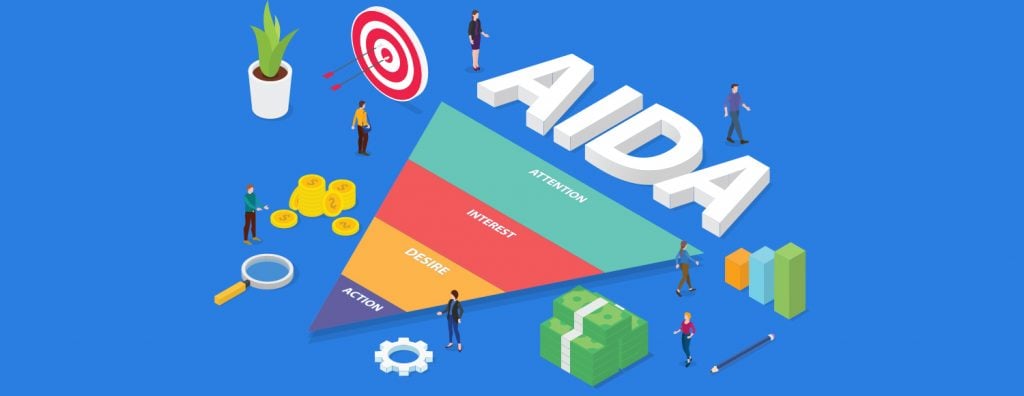Ever since the beginning of the digital age, customer purchasing behaviour has changed drastically. However, the AIDA marketing model remains. Thanks to its enduring relevance, it prevails both online and offline as the best-known marketing model of all time.
Consciously or subconsciously, the AIDA model still affects our customers (and us) in all our daily purchases. That is why this marketing model is still being applied to marketing strategies today.
Let’s take a step back and relook at the definition of the AIDA model. The AIDA model is a conversion marketing funnel. It is a process that involves the customer journey with the aim of convincing/encouraging customers and prospects to take action. For instance, the goal could be getting them to sign up for a complimentary gift, or even lead them to make a purchase.
Here’s a quick recap of what AIDA stands for.
Awareness
Whether you’re planning to launch a new product or service, the first step in marketing is to consider how to attract the attention of your consumers.
Interest
Once your customers are aware of your product or service, you want to increase their level of interest.
Desire
Now that your customers have shown interest in your brand, you want them to start desiring your products and services. Changing their mindset from “I like it” to “I want it”.
Action
The ultimate goal here is to drive the potential customer of the marketing campaign to initiate action and purchase the product or service.
With that, you can see that the AIDA model is a process of adhering to the customer journey. Awareness leads to Interest, which leads to Desire, and finally, to Action.
How should you apply the AIDA model to your marketing strategy?
Once you’ve understood the different stages of the AIDA marketing model, it’s not difficult to apply it to your business. Essentially, this model is here to guide you on the how(s) and when(s) to communicate with your customers during each of the stages. This is so you can better plan your marketing deliverables through different platforms after having identified their engaging touchpoints, and also better presenting the different types of information your customers require at each stage.
Let’s go through some key questions and examples for each stage:
Awareness
Never assume that everyone has heard about your brand. You want to reach a level where not only new prospects get an opportunity to learn about your brand, but also maintain a top-of-mind-awareness for your existing customers. Meaning, when a product, service, or a certain problem has arisen, they immediately think of your brand. For example, if a customer mentions that they’re looking for furniture, the first thing that comes to their mind is IKEA, or if someone is thirsty, they immediately think of Coca-Cola. That’s the level of awareness you should have in mind for your brand.
Key questions to ask:
- How do we make buyers aware of our products or services?
- What is our outreach strategy?
- What is our brand awareness campaign?
- Which tools or platforms do we use?
- What should the messages be?
Interest
Now that people are aware of your brand, the question you should ask is, “What am I going to do with that interest?” in which, the obvious answer is to retain that interest. At this stage, it’s best to ensure that all advertising information is broken up and easy to consume. The key here is to focus on your messaging to convey only what’s important. This can be further achieved by creating interesting and creative copywriting, as well as creative ad designs. For example, you can focus your messaging based on your product/service USPs – namely, why they are different and why your brand is better than your competitors. Doing so can further pique their interest.
Key questions to ask:
- How will we gain their interest?
- What is our content strategy?
- Is social proof available to back up our reputation?
- How do we make this information available, and where? (i.e on the website, via videos, customer ratings, etc.).
Desire
Although the Interest stage appears similar to the Desire stage (while also going hand-in-hand together), they’re not entirely the same. At the Interest stage, it’s more about your brand identity, whereas the Desire stage concentrates more on the emotional aspect related to brand personality. At this stage, your goal is to make customers realise why they ‘need’ your product/services. You’re addressing a pain point to which your brand can provide the solution. It’s an appropriate stage to present the benefits of your brand—which ultimately drives customers to purchase something.
Key questions to ask:
- What makes our product or service desirable?
- How do we interact personally to make an emotional connection?
- Online chat? Immediate response to Twitter feed? Share tips and advice?
Action
Last but not least is the Action stage. Now that you’ve successfully gained your audience’s interest and desire, they’re only one step away from converting into a customer. At this final stage, your goal is to have them initiate an action that’s aligned with your objective. In other words, carry out a transaction for your product/service. The best practices often include a call-to-action on every advertising material to get an immediate response from the consumer. Spotify’s Free Trial ad is a good example. They explain why you should try out their free trial, the benefits of it, and a clear CTA button that says “Start the trial”.
Key questions to ask:
- What should the call-to-action say and where do we place them?
- Is it easy for consumers to connect, and where would they expect to find it?
- Think about which marketing channel/platform you are using and how to engage (i.e. across emails, website, landing pages, etc.).
Looking for a marketing strategy that works for your brand? Speak to an expert today — contact us at hello@admiral.digital.
